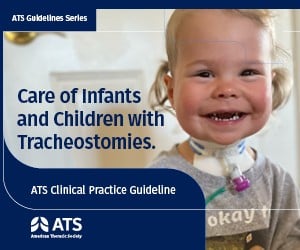Top Stories
New Guidelines Released for Tracheostomy Decisions in Children

UPDATE: The American Thoracic Society (ATS) has just released groundbreaking clinical practice guidelines designed to assist parents and caregivers in making critical decisions regarding tracheostomy for children. Published online today, October 22, 2025, in the American Journal of Respiratory and Critical Care Medicine, these guidelines aim to ease the emotional burden faced by families during these challenging times.
A tracheostomy involves the surgical insertion of a tube through the neck into the windpipe, enabling easier breathing for patients. However, Dr. Christopher Baker, co-chair of the guidelines and director of the Ventilator Care Program at Children’s Hospital Colorado, emphasizes that while this procedure can be life-saving, it may not always yield positive outcomes.
“A tracheostomy can save a life, lengthen a life, and improve the quality of life. However, this is not always true,” said Dr. Baker. He stresses the importance of shared decision-making between healthcare providers and families, noting that the guidelines are crucial for ensuring optimal care for young patients.
The guidelines, developed by a panel of experts and family members, focus on six essential questions surrounding tracheostomy care. They provide clear, evidence-based recommendations aimed at pediatric pulmonologists, critical care clinicians, and rehabilitation specialists.
Among the key recommendations are:
1. **Ethical Principles**: Apply ethical principles such as beneficence and autonomy to guide shared decision-making (strong recommendation, very low certainty of evidence).
2. **Caregiver Presence**: Ensure an awake and alert trained caregiver is always present with children at risk of complications related to tracheostomy (strong recommendation, very low certainty of evidence).
3. **Airway Evaluation**: Conduct a complete airway evaluation before any decannulation attempt in children with tracheostomies, assessing various parts of the airway (strong recommendation, low certainty of evidence).
Parents like Crystal Costante, who has a ventilator-dependent child with a tracheostomy, express relief and hope regarding the new guidelines.
“This guidance gives me a sense of hope and relief as a parent. It shows that healthcare providers are recognizing the importance of including families as true partners in care,”
she stated, emphasizing the value of shared knowledge and experience in improving patient outcomes.
This new guideline marks the ATS’s first comprehensive clinical practice guideline on tracheostomy since 1999, reflecting the organization’s commitment to advancing scientific rigor in pediatric care.
Dr. Baker acknowledges the challenges of implementing these guidelines in resource-limited settings, stating,
“We realize that some of our recommendations may be difficult to implement in settings with limited resources, such as rural areas or low/middle-income countries.”
A follow-up study is in the works to assess the applicability of these guidelines in diverse healthcare environments.
As families grapple with the complexities of tracheostomy decisions, these new recommendations provide a vital resource to ensure better outcomes for children requiring respiratory support. The ATS continues to develop additional implementation tools and resources for clinicians.
For complete details on the recommendations, visit the ATS website. This urgent update is crucial for families and healthcare providers navigating the often overwhelming landscape of pediatric respiratory care.
-

 Business4 days ago
Business4 days agoUK to Finalize Stablecoin Regulations by 2026, Boosting Crypto Sector
-

 Business5 days ago
Business5 days agoU.S. and U.K. Target Cybercriminal Networks, Seize $15 Billion
-

 World4 days ago
World4 days agoMilitary Artillery Plan Sparks Safety Concerns Along California Highway
-

 Lifestyle5 days ago
Lifestyle5 days agoKISS OF LIFE’s Natty Dazzles in Micro-Shorts at Seoul Event
-

 World5 days ago
World5 days agoTrump Signals Reluctance to Sell Tomahawk Missiles to Ukraine
-

 Business5 days ago
Business5 days agoCalifornia to Eliminate All Plastic Bags from Stores by 2026
-

 Sports5 days ago
Sports5 days agoDomenico Doran’s Stellar Performance Leads Bishop Amat to Victory
-

 Entertainment5 days ago
Entertainment5 days agoLouisiana Senate Raises Concerns Over Medicaid Cuts Amid New Bill
-

 Entertainment5 days ago
Entertainment5 days agoUtah Communities Rally as Government Shutdown Strains Resources
-

 Sports5 days ago
Sports5 days agoTrade Low, Trade High: Key NHL Players to Consider Now
-

 Science2 days ago
Science2 days agoAncient Dinosaur Discovery in Argentina Reveals Evolutionary Insights
-

 Health2 days ago
Health2 days agoUncovering the Hidden Link Between Knee Pain and Hip Issues









